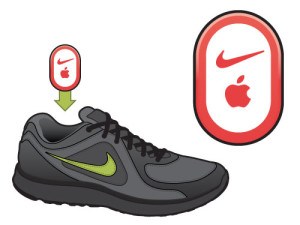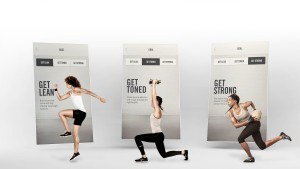How Nike swooshed away from its competition

When I was a teenager I would happily showcase Nike, Adidas, or Puma shoes on my feet. All brands looked just as appealing to me. Yes, there were the exceptions and for a couple of season one brand just got more than his fair share of attention (I still can’t believe how much I loved my Adidas Galaxy. Did I really believe that wearing shoes that looked like a spaceship was cool?), but all in all, no undisputed winner.
The days of sneakers everyday have ceded the scene to all sorts of high-heels, ballerinas, boots, wedges now – my horizons opened up to a whole new world. But every time I go to my gym’s locker room or when I get ready to go for a run, there they are: my Nike’s. How is possible that from being a brand among others, Nike managed to create such a strong bond with me?
 First off, Nike was the first sports fashion company to partner with Apple and to supply additional software (and hardware) for runners to better track
First off, Nike was the first sports fashion company to partner with Apple and to supply additional software (and hardware) for runners to better track
their runs. After hearing my friends raving about it, I literally ran to the store to buy the inexpensive sensor to place in my (brand new) Nike’s. The new shoes feature a slot underneath the sole where to place the sensor. It was great: I could leverage my iPod, with the addition of a piece of hardware that cost €20, to receive insights and analytics on my performance that before only €100+ watches from Garmin would deliver. And this service was branded Nike.
As the iPhone started becoming ubiquitous, Nike didn’t fall behind. The Nike Running App is, to my experience, has consistently been the best running app out there. It maps your run and tracks your pace, it allows you to compete with your friends, or to tailor a personalised training. Serena Williams’ voice congratulates you at the end of your workout! How motivational is that? Through the desktop portal, your Nike profile gives you all sorts of insights and analytics and you can see all the runs you have ever made. And if you are a data nerd like me, you end up visiting that portal frequently and really digging in those stats.

Hit after the other, the Nike Training Club became part of my daily routine as soon as I downloaded it in my phone. This app features circuit training with a virtual personal trainer. It is uniquely catered to women. The UI is fantastic and the journey through the app makes it one of the most intuitive complex apps I’ve ever come across. And again, all sorts of integration with your running profile are present, the social aspect is strong: it has a place on my home screen.
Nike’s digital presence is unrivalled. And all of the products that they have created online are free for any consumer to download and use. You don’t need to wear Nike shoes to use the Nike Running app to train for your next half marathon and you don’t need Nike leggings to to the ‘the total body sculpting’ workout on the Nike Training Club. But at the end of the day, when I go to store to get another piece of clothing, I am now incredibly loyal to a brand that invests its assets in developing digital services I love – and that does so much better than many of its Silicon Valley ‘competitors’.



First, I -definitely- think that wearing shoes that look like spaceships are cool, but then again, I carry a backpack that looks like a shark. Your review almost sold me a pair of Adidas! (although I’m not quite in the market for more shoes right now).
But you’re right- cooler than a galaxy print is that ability to have the shoes quantify your life a little more. The hardware integration would make me more likely to buy the Nike shoes. I’m less sold on the effectiveness of the Training Club- if it’s free to use without buying any of their products, and doesn’t integrate with their products, I can’t see myself being more likely to buy their leggings because of it even if I used and loved the app.
Anyway, great post, and I’m off to go download some Nike apps!
Here is how it goes with the Nike Training Club. The app pushes their e-commerce platform and suggests a Nike outfit for every workout. Maybe not as effective as the hardware integration in the shoes (but note thought that now the hardware integration has disappeared – you just need an iPhone to access the full functionality of the Nike Running app), but it is effective in marketing all their new lines of sports clothing, doubling down on target audience!
Kudos for the shark backpack. I’ll be on the watch for it, Mr Cranberry Fan.
Here is how it goes with the Nike Training Club. The app pushes their e-commerce platform and suggests a Nike outfit for every workout. Maybe not as effective as the hardware integration in the shoes (but note thought that now the hardware integration has disappeared – you just need an iPhone to access the full functionality of the Nike Running app), but it is effective in marketing all their new lines of sports clothing, doubling down on target audience!
Kudos for the shark backpack. I’ll be on the watch for it, Mr Cranberry Fan.
Great post; I’d also be curious to know how they managed to make this transition from essentially a design and manufacturing company (a maker of shoes and clothes!) to a software company. As we have discussed in class, the product cycle times are quite different; the innovation required is different; your competitors are different. What is most impressive to me is that Nike managed to make this change without making its pains obvious to the consumer – as a fellow Nike fan, I didn’t notice the challenge Nike had to conquer and could simply lay back (or run!) and enjoy the results.
I actually wouldn’t call Nike a software company – sports goods are still at the heart of their customer proposition. But I agree with you on how fascinating this is that they have got software completely right. It would be very interesting to dig deeper into how! Maybe it is because the people who work at Nike really understand what an athlete wants and can deliver on it – being the product a pair of shoes or an app.
Really enjoyed you post HelloSof. Nike has been doing it across sports so despite I’m not a runner I did joined their soccer training platforms that accompanied one of the most successful marketing campaign (for all of those who remember “the Cage””. Despite, as a big sports fan, I have to say that for very technical runners or players of any sport, competitors do seem to have better alternatives. It looks like Nike has been aiming to the masses, to that average runner who really won’t need the best of the best, but that likes to have a good pair of shoes. In this effort, all of what you’ve said has been fundamental. My only concern is how do you see Nike going forward. Competitors could easily imitate its digital strategy and unless they use all the data they have gathered to come up with revolutionary product innovation, some may say that this will only end up being a replicable marketing strategy. What are your thoughts?
Thanks for the post HelloSof. I agree with Charles that Nike does not seem to be targeting professional athletes and that competitors might be doing better from that perspective. Additionally, although it seems to have innovated over the past few years, it is not expanding beyond what is currently being offered by existing products. In order to be successful at driving people from using their free app without necessarily being loyal to products, it should experiment with offering access to an additional premium offering with a product purchase or multiple purchases that are above a specific value. Yet, to be able to do this, they should introduce a service beyond what is currently offered in the market. I am not sure what that could be, but competitors will eventually follow their lead and create apps as good or better.
Great post HelloSof! I too am a fan of the Nike training club App, purchased sensors for my Nike+ shoes, and even had a first generation nike fuelband (may this technology rest in peace). I do think that as others have said, Nike is catering to the mass market, and “average” runners who myself who like competition, want to push themselves further with simple to use, social sharing and technology with a clean interface. As they are in a volume business, I think this business model makes complete sense. Instead of competing for clientele that would be better served by Strava, Nike focuses its energy on controlling “athletic mindshare” for everyday people and student-athletes. To date, I would agree that it has been a solid strategy and as long as they continue to know when to shift their focus (i.e. the decision not to continue with the fuelband), I think their core product categories will continue to reap the rewards of freebies such as the training club and running apps.
Some of us still wear their sneakers most days 🙂
I agree that Nike is kind off winning in the US but I’m not sure this is the picture globally.
Even if you buy the forecasts that Nike global market share at 2020 will be ~27% this isn’t a monopoly or a clear win. I think Nike needs to keep working on maintaining its innovative brand and image and act more on the global arena.